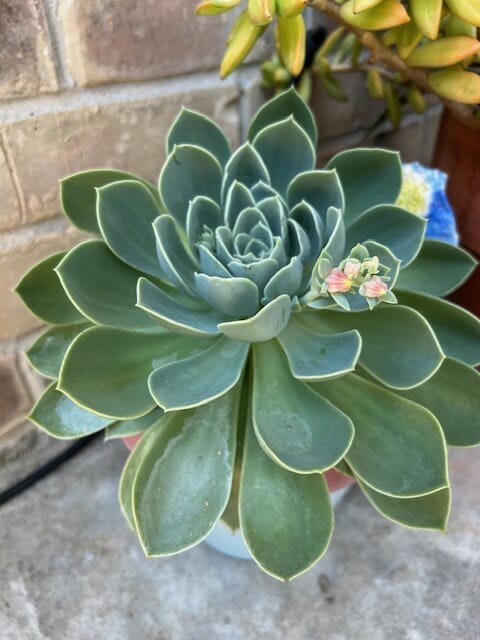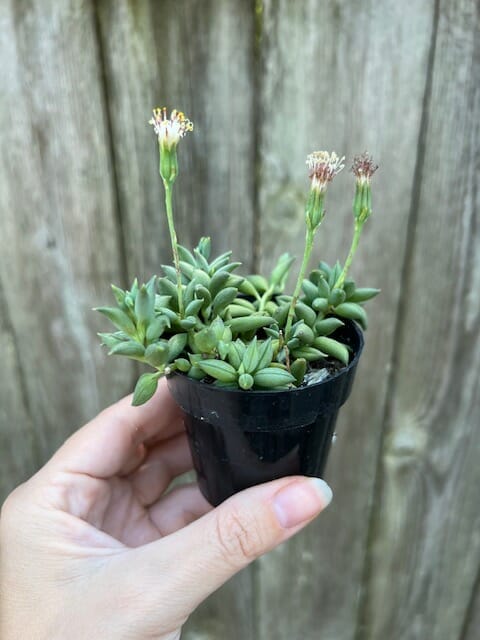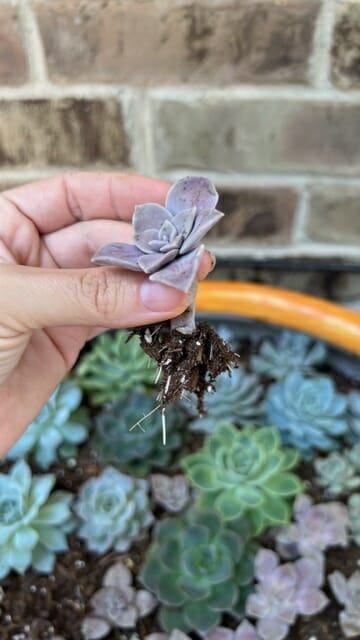Welcome, green thumbs and succulent lovers!
If you’re here, you’re likely seeking guidance on replanting succulents. Whether you’re aiming to give a growth boost to your beloved plants or managing an overly crowded pot, replanting is a vital part of succulent care that can’t be overlooked. Lucky for you, you’ve landed on the right page.
In this article, we’ll delve into the ins and outs of replanting succulents, providing you with all the necessary knowledge, practical tips, and common pitfalls to avoid.
So, roll up your sleeves and dig into this beautiful world of succulent care together!

The Importance of Repotting Succulents
Replanting succulents is much more than simply moving a plant from one pot to another. It’s a critical part of succulent care, playing a significant role in these charming plants’ overall health, growth, and longevity.
Let’s explore the key reasons why you should transplant succulents:

Promoting Healthy Growth
- Room for growth: Over time, succulents outgrow their current pots. Replanting provides them the much-needed space to expand, ensuring continued growth and development.
- Nutrient uptake: Fresh soil, during replanting, provides a new supply of nutrients, supporting the health and well-being of your succulents.
- Root health: Replanting lets you loosen compacted soil, promoting better root aeration and overall plant vitality.
Controlling Pests and Diseases
- Pest inspection: When you replant, you get a close look at your succulent’s root system, enabling you to detect and deal with any hidden pests before they cause substantial harm.
- Disease prevention: Similarly, replanting allows you to inspect for signs of root rot or other diseases, so you can intervene early and protect your plant’s health.
Refreshing Depleted Soil
- Renewal of nutrients: Over time, succulents extract all the nutrients from their soil, depleting it. Replanting in fresh soil ensures a renewed supply of essential nutrients for your succulents.
- Improved drainage: Fresh soil also improves drainage, preventing waterlogging and associated problems like root rot.
Preparing for Replanting: Materials and Preparations

Getting ready to replant your succulents involves careful planning and the right materials. Let’s dive into the preparation process to ensure you have everything in place for a successful replanting experience.
List of Necessary Materials
- New pots: Choose pots with drainage holes to prevent water from accumulating at the bottom.
- Fresh succulent soil mix: A well-draining soil mix explicitly designed for succulents.
- Gardening gloves: To protect your hands during the replanting process.
- Trowel or spoon: Useful for transferring soil and handling small succulents.
- Clean, sharp scissors or pruning shears: For trimming roots or removing dead leaves from the mother plant.
Choosing the Right Pot
The choice of pot plays a significant role in the success of replanting succulents.
- Size: The pot should be large enough to accommodate the succulent’s root system. Oversized pots can lead to over-watering problems as the soil may stay wet for too long.
- Material: Ceramic and terra cotta pots are excellent choices as they allow the soil to dry out more quickly than plastic pots.
- Drainage: Always choose pots with drainage holes to prevent waterlogging and the risk of root rot.
Importance of the Right Soil Mix
Choosing the right soil mix is fundamental for the well-being of your succulents.
- Well-draining: Succulents need soil that drains quickly. A well-draining succulent mix, often containing coarse sand, perlite, or pumice, is essential.
- Nutrient-rich: While drainage is crucial, don’t forget to add nutrients, helping the plant thrive in desert, arid climates. Thus, look for a soil mix that contains compost or other organic matter.
- pH balance: Succulents prefer slightly acidic to neutral pH. A succulent-specific soil mix will typically have the correct pH balance.
Step-by-Step Guide to Replanting Succulent Plants
Now that you’re fully prepared, it’s time to replant your succulents. This process might seem difficult, but with our step-by-step guide, you’ll handle it with ease and confidence.

Removing the Succulent from the Old Pot
The first step in replanting involves carefully removing your succulent from its current home.
- Loosen the soil: Start by loosening the soil around the edges of the pot with a spoon or a small trowel.
- Gently remove the plant: Tilt the pot and gently ease the plant out, making sure to support the main stem or rosette. Also, ensure not to damage the outer fibers of the root ball.
- Rescue remaining roots: If some roots stay in the pot, remove them and reattach them to the main plant if possible.
Inspecting for Root Rot
- Inspect for pests and diseases: Check the roots for any signs of pests, diseases, or root rot. If you spot any, treat them accordingly before replanting.
- Trim if necessary: Trim the roots slightly with clean, sharp scissors if the roots are overly long or tangled.
Filling the New Pot with Soil
The next step is to prepare the new pot for your succulent.
- Add drainage material: Consider adding a layer of small stones or gravel at the bottom of the pot to improve drainage.
- Add soil: Fill the pot about one-third with fresh succulent soil mix.
Setting the Succulent in Its New Pot
Now, it’s time to introduce your succulent to its new home.
- Position the plant: Place your succulent in the center of the pot. The base of the stem or the lowest leaves should be slightly above the pot’s rim.
- Add more soil: Fill the pot with fresh soil, but leave some space at the top to make watering easier.
When to Start Replanting Succulents

Knowing when to replant your succulents is as crucial as knowing how to do it. So, Let’s look into how you can identify the ideal time to replant and the signs that your succulent might be ready for a new home.
Identifying the Right Time for Replanting
- Seasonal considerations: Spring is generally the best time to replant succulents as it is their active growing season. The warmer weather and longer daylight hours stimulate growth, helping your succulents recover faster from the transplant.
- Post-purchase potting soil: If you’ve just bought a succulent plant, give it a few days to acclimate to its new environment before replanting or adding potting mix.
Signs That You Need to Repot Succulents
Sometimes, your succulents may give off signals indicating it’s time to move them to a new pot. Here are the signs you should watch out for:
- Outgrown pot: If your succulent seems too big for its pot or the roots are growing out of the drainage hole, it’s likely time to upgrade to a larger container.
- Health issues: If your succulent shows signs of disease or pest infestation, replanting it can help you control the problem and give the plant a fresh start.
- Stunted growth or wilting: If your succulent isn’t growing as it should or the leaves are wilting, it could be due to depleted soil nutrients. Replanting in fresh soil can help solve this problem.
Common Mistakes to Avoid When Replanting Succulents

Despite the best intentions, replanting succulents can sometimes go awry if certain common mistakes are made. By knowing how to care for your succulents, you can successfully navigate the replanting process and ensure your succulents thrive in their new environment.
Overwatering or Underwatering After Replanting
Watering is critical to succulent care, especially after replanting, but getting it wrong can harm your plant.
- Overwatering: Succulents are drought-tolerant and excess water can lead to root rot. After replanting, allow your succulent a few days to adjust before watering, and then only water when the soil is thoroughly dry.
- Underwatering: On the other hand, insufficient watering can deprive your succulent of the necessary hydration it needs to establish in the new pot.
Using the Wrong Soil Mix
The type of soil you use can make or break your succulent’s health.
- Poor-draining soil: Using soil that retains too much water can lead to waterlogging and root rot. Ensure your soil mix is well-draining, typically containing elements like coarse sand, perlite, or pumice.
- Nutrient-deprived soil: While succulents don’t require nutrient-rich soil like some other plants, they still need some nutrients to thrive. Make sure your soil mix contains some organic matter.
Replanting at the Wrong Time
The timing of replanting can also significantly impact your succulent’s adjustment and growth.
- Cold weather replanting: Avoid replanting in the colder months as succulents enter dormancy and their growth slows. Spring or early summer is ideal.
- Immediate post-purchase replanting: For newly purchased succulents, wait a few days to acclimate before replanting to avoid additional stress.
Takeaway: Embrace the Joy of Replanting Succulents
Replanting succulents is essential to their care routine, fostering health and encouraging vibrant growth. If you’re ready to elevate your succulent journey, embrace the joy of succulent care with Succulent Bar. Our Succulent boxes, stocked with various unique and beautiful succulents and other ornamental plants, are perfect for replenishing your collection.
Furthermore, if you want to deepen your understanding and share the joy of succulent care, why not join one of our planting classes? They make for a fun, educational experience, and a perfect team activity.
Dive into the green world with Succulent Bar, and let’s grow together!



